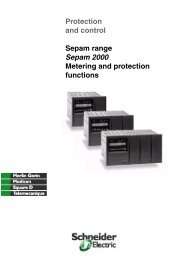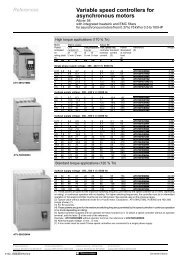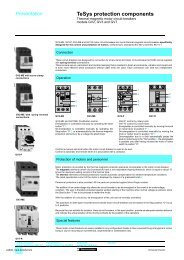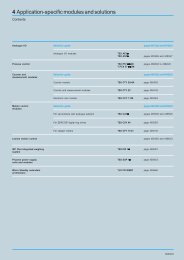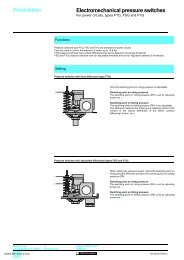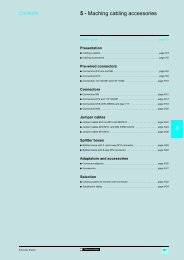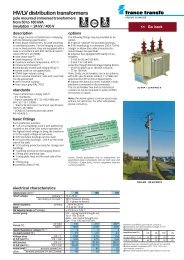Operator dialogue terminals - Trinet
Operator dialogue terminals - Trinet
Operator dialogue terminals - Trinet
You also want an ePaper? Increase the reach of your titles
YUMPU automatically turns print PDFs into web optimized ePapers that Google loves.
Functions (continued) 3<br />
Softwares<br />
and Web servers 3<br />
Monitor Pro V7.2 supervisory software<br />
3<br />
Monitor Pro<br />
Client<br />
Monitor Pro<br />
Server<br />
3<br />
2<br />
1<br />
3<br />
3 3<br />
Client Builder<br />
Graphic interface and animation<br />
OPC Client<br />
ActiveX<br />
alarms<br />
Alarm<br />
server<br />
ActiveX<br />
trends<br />
Trend<br />
server<br />
1 Real-time database<br />
2 OPC Server<br />
3 Tasks: calculation, reporting, ODBC interface, API<br />
communication, etc.<br />
Run-time environment (continued)<br />
Server systems<br />
The system’s main feature is that all the data is stored in the real-time database 1<br />
which permanently displays the status of the process currently running.<br />
The real-time database is central to all tasks 3 in the process of execution. It resides<br />
intheserver’sRAMandactsasbothastoragedeviceandaninter-process<br />
communication mechanism. All tasks share information in the real-time database by<br />
reading from and writing to the real-time database.<br />
Finally, the server automatically performs certain operations, such as:<br />
b recording and generating alarms<br />
b regularly archiving data on the trend server (historical trends database)<br />
Clients<br />
The client applications connect to the server systems via their OPC client<br />
interface and access the Monitor Pro real-time database.<br />
During run-time, the clients provide interactivity between the control system and the<br />
operators with a graphic interface, alarm display and trend curves, etc.<br />
Different clients can access the same server or multiple servers via the network,<br />
depending on application requirements. Communication between the clients and<br />
server systems takes place in real time via the OPC interface.<br />
Real-time database for the server systems<br />
The real-time database stored in the rapid access RAM is the heart of Monitor Pro<br />
V7.2 supervisory software. This database contains all the data coming from or going<br />
to the process being supervised and is available for supervision processing.<br />
The database size is determined by the server defined by the Monitor Pro V7.2<br />
software that is used (ranging from 300 I/O and 4800 tags to an unlimited number of<br />
I/O and tags).<br />
This application image comprises objects defined as symbols representing binary<br />
data, single-length words (16 bits), double-length words (32 signed bits), floating<br />
point values (64 bits) and text messages (up to 256 bytes max.).<br />
Each task can access the whole real-time database and uses this as a means of<br />
exchanging data with other tasks. This method of communication reinforces the<br />
various tasks’ independence from each other.<br />
Diagnostics function<br />
Alarm supervisor<br />
Alarms are generated as a condition of every element in the real-time database (bit<br />
or numeric).<br />
The Alarm supervisor offers the following functions:<br />
b detection, display (ActiveX), archiving and real-time printing<br />
b detection conditions on bits or analog values<br />
b user comments added to an alarm and entered in the log<br />
b alarms acknowledged individually or as a group<br />
b details of tag names, messages, acknowledgement data, duration, group, etc.<br />
displayedinAlarmViewer(readytouseandconfigurablewithActiveX)<br />
b alarm panel (ready to use with ActiveX) that can be displayed in any mimic with a<br />
maximum of three lines for the last three alarms<br />
b real-time printing when an event appears and disappears and on return to normal<br />
b filter and sort functions available according to user-defined criteria<br />
b alarms grouped by user-defined parameters (for instance, type, area, priority, etc).<br />
b distribution of alarms and acknowledgements (by a single Alarm server).<br />
The alarm function supports parent/child relationships to prevent the generation of<br />
nuisance alarms in the event of a whole stream of faults.<br />
3/30



